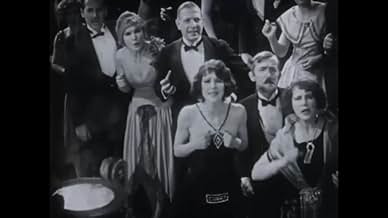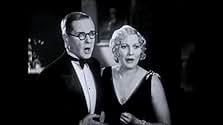Agrega una trama en tu idiomaA young man of society wants to make an expedition to Africa, but his fiancée asks him for help with one of her father's guests shortly before his planned departure. Her suspicions about tha... Leer todoA young man of society wants to make an expedition to Africa, but his fiancée asks him for help with one of her father's guests shortly before his planned departure. Her suspicions about that guest are serious: this man tries to steal one of her father's rubies, and she and her f... Leer todoA young man of society wants to make an expedition to Africa, but his fiancée asks him for help with one of her father's guests shortly before his planned departure. Her suspicions about that guest are serious: this man tries to steal one of her father's rubies, and she and her fiance' are kidnapped and taken to a house where strange things happen. The whole thing bec... Leer todo
- Dirección
- Guionistas
- Elenco
- Sojin
- (as Sojin)
- Satanist
- (sin créditos)
- Party Guest
- (sin créditos)
- Hair-Pulling Lunatic
- (sin créditos)
- Satan's Chosen One
- (sin créditos)
Opiniones destacadas
Typical of many latter-day Silents, the horror element here is mingled with intermittent doses of comedy – though not so much as in, say, THE CAT AND THE CANARY (1927), with which it shares leading man Creighton Hale in a similar role; he's partnered in this case with the popular and tragic Thelma Todd, who comes off somewhat better than Laura La Plante from the earlier film (from the cast, I also recognized Sojin and the ubiquitous Angelo Rossitto – but had no idea that 'The Spider' was played by Sheldon Lewis, who had over-acted so horrendously in the rival 1920 version to the John Barrymore DR. JEKYLL AND MR. HYDE). Also, like THE CAT AND THE CANARY, Christensen's film boasts a very striking visual style highlighted by inventive – and impressive – art direction, camera-work (simulating, for instance, the motion of going up the various floors of the main 'haunted house' set), lighting and editing (at one point, a door opening is quickly followed by a succession of gunshots, only to be revealed as the hero engaged in target practice).
What makes the film unique, perhaps, is its relentless parade of grotesques (a dwarf, a gorilla, a pock-marked cripple, an ape-man, a sinister Oriental, an androgynous servant, etc.) and assorted maidens (either scantily-clad hostages or perverted followers of a satanic cult); all of this gives the film a creepy overall tone which is not easy to shake off and has seldom been replicated with such gusto: the climactic orgy is downright chilling – a veritable Pre-Code moment – with its suggestive flagellation (anticipating a famous scene in THE SIGN OF THE CROSS [1932]) and satanic audience (though the Devil himself is depicted as nothing more scary than a mysterious figure in a hood!). Which brings us to the cop-out ending that's moralistic (in a good-natured way) but not really unexpected for a horror film of its time (think London AFTER MIDNIGHT [1927]) and, in any case, shouldn't be seen as too much of a let-down considering just how satisfying – and immensely enjoyable – the lead-up to it has been!
In conclusion, I wanted to comment on Christensen's Hollywood career: one may think it a shame that he seems to have gotten stuck in the 'old dark house' subgenre – what with his having directed two more of those, THE HAUNTED HOUSE (1928) and HOUSE OF HORROR (1929), both also featuring Todd and both of which, unfortunately cannot be assessed due to unavailability – but, the fact remains that he seriously bungled his one chance at working with the great Lon Chaney on the hoary and ill-suited Russian Revolution melodrama, MOCKERY (1927). However, while his work may have been overshadowed by that of other European directors employed in Hollywood during the final days of the Silent era, this viewing of SEVEN FOOTPRINTS TO Satan more than restores his reputation as a visual stylist and someday I would love to be able to check out his only remaining surviving film, the intriguing THE DEVIL'S CIRCUS (1926)
*** 1/2 (out of 4)
Very good and creepy film from director Benjamin Christensen about a couple (Thelma Todd, Creighton Hale) who are kidnapped and taken to an old dark house ran by Satan. Inside the house the two are terrorized by a dwarf (Angelo Rossitto of Freaks fame), a gorilla, an ape man like creature and other weirdos. The atmosphere of this film is so incredibly thick that you'll actually feel as if you're walking among all of these characters. There are several creepy moments as the couple walk around this house, which just has one weird room after another. The film isn't as great as the director's Haxan but it's still among the best of its genre. The set design is terrific and the editing is among some of the best I've seen from this period. You easy to see that this film influenced Universal's Dracula, Paramount's Island of Lost Souls and some of the orgy scene from Kubrick's Eyes Wide Shut appears to have been influenced by this film.
Paul Leni and Roland West may have been the only directors as talented as him working on these types of films at the time, but in terms of the quality of the image, the composition, the framing and the mise-en-scene, he surpasses even them. Each had their own specialty, though; Leni-set design; West-special camera effects.
His previous film, 'The Haunted House' (1928) was at the time hailed as his best of these. It may be the greatest 'lost' horror film in terms of artistic merit. He then made 'Footprints' and 'House of Horror' in 1929. Only 'Footprints' seems to have survived to this day.
The only version of this film that seems to be available is an Italian title-carded version of which I viewed a copy. Luckily for me, I had someone translating Italian for me (my sister) so I could figure out what was going on. I still felt like I was missing something, so I watched it again.
Upon second viewing, and having known the plot, I was able to view the real story of this film - the movement of images, the magnificent cutting and the chiaroscuro - still excellent in this worn print. This film actually seems to be about movement rather than a plot. The camera does not move much, but it does in key spots. The interplay and blocking of the characters is outstanding and is seamlessly edited to create a truly visceral experience.
The constant parade of gorillas, dwarfs, madmen, and wenches that our hero (Creighton Hale) experiences is exhaustive. Christensen takes us as our designer and guide in this nearly literal carnival ride through the 'house of Satan'. Some of the horror images are as amazing as you will see from the 1920s!
Sadly, since this film is finally available, after being believed lost for many years, it has garnered no attention. Perhaps because it is an exercise by Christensen, and not a once-in-a-lifetime masterpiece like Haxan, no one is as interested. Perhaps the ending, which may disappoint many, is the reason. Or maybe because it is only in Italian? It is certainly not the filmmaker's fault.
Christensen, like Rex Ingram was very painterly. However, even more than Ingram, Christensen had really mastered the editing of his 'painted' images and has created something here that deserves much attention from silent film scholars and fans. If not for his lack of a moving camera, he was as skilled and as talented as almost any director in the 1920s. 'Footprints' is an artistic gem that deserves more attention from silent and horror film fans.
THE VERDICT -- This is brisk film-making, with many interesting moments and motives. To say anymore would spoil what I consider to be a great ending. Sheldon Lewis, who previously played Dr. Jekyll and Mr. Hyde (1920), is wonderful as "The Spider." Wow, Laska Winter! Thelma Todd!
FREE ONLINE -- Two versions. (1) 59-minute silent Italian print, with excellent picture, and at times with English translation of the intertitles, (2) 76-minute silent "restored" version by Serial Squadron, with actually a terrible picture but much more of it, haha, and English intertitles.
¿Sabías que…?
- TriviaA 35mm positive print is held by the Danish Film Museum.
- Versiones alternativasReleased in three versions, the domestic sound part-talkie version, an international sound version and a silent version. Two prints of the international sound version survive, both with Italian intertitles and will a title card before the film title declaring it to be "il film sonoro" or a "synchronized sound film."
- ConexionesReferenced in You Must Remember This: Thelma Todd (Dead Blondes Part 2) (2017)
Selecciones populares
Detalles
- Tiempo de ejecución1 hora
- Color
- Relación de aspecto
- 1.33 : 1
Contribuir a esta página


































